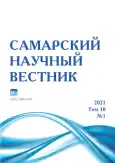Трансформация растительности в условиях неинтенсивной сельскохозяйственной нагрузки (на примере окрестностей деревни Октябрьск Учалинского района Республики Башкортостан)
- Авторы: Назаренко Н.Н.1, Батюшева С.Ю.1
-
Учреждения:
- Южно-Уральский государственный гуманитарно-педагогический университет
- Выпуск: Том 10, № 1 (2021)
- Страницы: 121-127
- Раздел: Общая биология
- URL: https://journals.rcsi.science/2309-4370/article/view/70325
- DOI: https://doi.org/10.17816/snv2021101119
- ID: 70325
Цитировать
Полный текст
Аннотация
Для окрестностей деревни Октябрьск Учалинского района Республики Башкортостан проведено исследование растительности и биотопов, переходных между рудеральными и естественными. Изученная растительность характеризуются сравнительно низкими показателями биотического разнообразия и высокими показателями доминирования – определено в описаниях 56 видов сосудистых растений, преобладают 10-видовые растительные сообщества с 2–3 четко определяемыми доминантами и содоминантами, в качестве которых для большей части сообществ выступают рудеральные виды. Методами многомерной статистики определено 15 растительных ассоциаций, биотопы которых отличаются по режимам ведущих абиотических факторов, а сами ассоциации являются для этих факторов индикаторными. Выделенные ассоциации формируют ряды ординации – определены три биотопических центра (рудеральный, степной и березняковый), три ряда биотопического замещения и три ценотических ряда, связанных с высокой и умеренной пастбищной нагрузкой, формирующие сукцессионные серии пастбищной дигрессии и единую систему сукцессионной динамики растительности изученной территории. Установлено, что ведущими факторами формирования ценозов является уровень пастбищной нагрузки, а формирования биотопов также режимы почвенного увлажнения и его переменности, омброрежим (уровень атмосферного увлажнения), терморежим и режим континентальности.
Полный текст
Открыть статью на сайте журналаОб авторах
Назар Николаевич Назаренко
Южно-Уральский государственный гуманитарно-педагогический университет
Автор, ответственный за переписку.
Email: nnazarenko@hotmail.com
доктор биологических наук, профессор кафедры химии, экологии и методики обучения химии
Россия, ЧелябинскСветлана Юрьевна Батюшева
Южно-Уральский государственный гуманитарно-педагогический университет
Email: svetlana.batyusheva@yandex.ru
студент естественно-технологического факультета
Россия, ЧелябинскСписок литературы
- Абрамова Л.Н., Голованов Я.М. Обзор высших единиц синантропной растительности Европейской части России // Сборник научных трудов ГНБС. 2016. Т. 143. С. 7–15.
- Миркин Б.М., Абрамова Л.М., Ишбирдин А.Р., Рудаков К.М., Хазиев Ф.Х. Сегетальные сообщества Башкирии. Уфа: БФАН СССР, 1985. 155 с.
- Ишбирдин А.Р., Миркин Б.М., Соломещ А.И., Сахапов М.Т. Синтаксономия, экология и динамика рудеральных сообществ Башкирии. Уфа: БНЦ УрО АН СССР, 1988. 162 с.
- Миркин Б.М., Наумова Л.Г., Ямалов С.М. Синантропная растительность Башкортостана: изученность, разнообразие, экологическое значение // Вестник Академии наук РБ. 2009. Т. 14, № 1. С. 18–25.
- Наумова Л.Г., Миркин Б.М., Мулдашев А.А., Мартыненко В.Б., Ямалов С.М. Флора и растительность Башкортостана. Уфа: Изд-во БГПУ, 2011. 174 с.
- Абрамова Л.М., Голованов Я.М. Синантропная растительность Республики Башкортостан: итоги исследований школы Б.М. Миркина // Фиторазнообразие Восточной Европы. 2018. Т. XII (3). С. 7–16.
- Суюндукова Г.Я. Синтаксономический анализ растительности населенных пунктов сельского типа Зауралья Республики Башкортостан: автореф. дис. … канд. биол. наук: 03.00.05. Уфа, 2008. 16 с.
- Синантропная растительность Зауралья и горно-лесной зоны Республики Башкортостан: фиторекультивационный эффект, синтаксономия, динамика / под ред. Б.М. Миркина и Я.Т. Суюндукова. Уфа: Гилем, 2008. 512 с.
- Муллагулов Р.Т., Ямалов С.М. Синтаксономия степных пастбищных сообществ в башкирском Зауралье // Вопросы степеведения. 2014. Т. 12. С. 110–113.
- Батюшева С.Ю., Назаренко Н.Н. Березняки окрестностей села Октябрьск Учалинского района республики Башкортостан // Актуальные вопросы биологии, географии, химии, безопасности жизнедеятельности и методики их преподавания: мат-лы всерос. (с междунар. уч.) науч.-практ. конф. Ишим: ИПИ им. П.П. Ершова (филиала) ТюмГУ, 2020. С. 5–11.
- Ханина Л.Г., Смирнов В.Э., Бобровский М.В. Новый метод анализа лесной растительности с использованием многомерной статистики (на примере заповедника Калужские засеки) // Бюллетень МОИП. Отд. биологический. 2002. Т. 107, вып. 1. С. 40–47.
- McCune B., Grace J.B. Analysis of ecological communities. MjM SoftWare Design, 2002. 300 p.
- Legendre L., Legendre P. Numerical ecology. Amsterdam: Elsevier Science B.V, 1998. 853 p.
- Didukh Ya.P. The ecological scales for the species of Ukrainian flora and their use in synphytoindication. Kyiv: Phytosociocentre, 2011. 176 p.
- Persson S. Ecological indicator values as an aid in the interpretation of ordination diagrams // Journal of Ecology. 1981. Vol. 69, № 1. P. 71–84.
- Мэгарран Э. Экологическое разнообразие и его измерение. М.: Мир, 1992. 184 с.
- Тихомиров В.Н. Методы анализа биологического разнообразия. Минск: БГУ, 2009. 87 с.
- Бельгард А.Л. Степное лесоведение. М.: Лесная промышленность. 1971. 321 с.
- Терентьев П.В. Метод корреляционных плеяд // Вестник Ленинградского государственного университета. 1959. № 9. С. 137–141.
Дополнительные файлы








